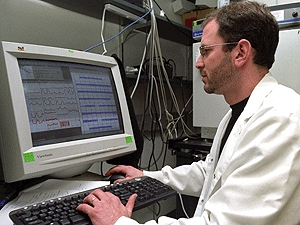Biologists have discovered a large biological clock in the smelling center of mice brains and have revealed that the sense of smell for mice is stronger at night, peaking in the nighttime hours and waning during daylight hours. The study is the first to show that mice have multiple biological clocks, opening the possibility that other mammals — including humans — could, as well.
A team led by Erik Herzog, Ph.D., associate professor of biology in Arts & Sciences, discovered the clock in the olfactory bulb, the brain center that aids the mouse in detecting odors. Results were published in a recent issue of The Journal of Neuroscience.

The olfaction biological clock, located in the front of the brain directly behind the nose, is hundreds of times larger than the known biological clock called the suprachiasmatic nucleus (SCN), located at the base of the brain. Cells in both the SCN and the olfactory bulb keep 24-hour time and are normally highly synchronized with each other and with environmental cycles of day-night.
“It’s been a question for some time whether the SCN functions as the only biological clock,” Herzog said. “One wouldn’t think that the ability to smell would cycle, but that’s what we show.
“I think now that the SCN is like the atomic clock — important for keeping central time — and then there are all of these peripheral clocks for timing tasks like sleep-wake, vigilance, digestion, olfaction, hearing, touch and vision, though not all yet found. It may be that the peripheral clocks are like individual wristwatches that we must periodically reset.”
Perhaps most surprising is the observation that the olfactory bulb clock can run independent of daily rhythms in sleep-wake or the SCN, making it the Big Ben of the mammalian circadian rhythm world.
“It seems to be one of those biological clocks that can keep running itself for a long time, even without the SCN,” Herzog said.
Herzog and collaborators Daniel Granados-Fuentes, Ph.D., research associate in biology, and Alan Tseng, a senior majoring in biology, put cedar oil on a cotton swab and allowed mice to sniff it for five minutes.
“We then counted the number of olfactory bulb cells that had been activated by the odorant,” Herzog said. “The gene cFOS is a marker for cells that were activated by the stimulus; we recorded the expression of that gene.”
They saw more of those cells light up — thanks to a bioluminescence marker associated with cFOS — in the olfactory bulb at night than in the day.
“The olfactory bulb might be more sensitive at night when the creatures are active than when they are resting in the day,” Herzog speculated. “This might help them find food or mates when they are hungry for food or for love.”
Do the results suggest humans should wear perfume or cologne at night and shun the bottle during the day?
“There are anecdotes in the literature about humans liking certain perfumes more during the evening than the morning, and there is some evidence that we also have daily rhythms in olfaction,” Herzog said.
Herzog’s next step is to study the olfactory behavior of mice.
“We’ll ask the mice to tell us when they can smell odors of different concentrations, and we hope to learn more about how and how much the clock modulates their sense of smell and which cells and genes are needed,” he said.
A key question raised by the olfactory bulb biological clock study is why multiple clocks exist.
“This idea of multiple biological clocks is new,” Herzog said. “We might need now to consider ourselves a clock shop. It appears that disrupting the coordination between these clocks is bad for our health, like in jet lag or shift work.”